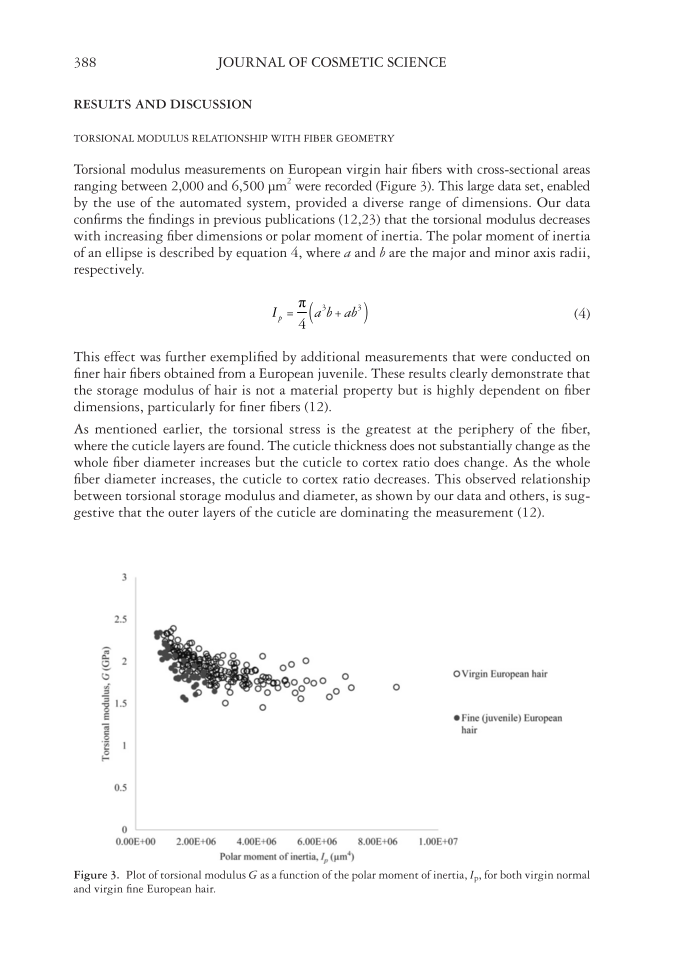JOURNAL OF COSMETIC SCIENCE 388 RESULTS AND DISCUSSION TORSIONAL MODULUS RELATIONSHIP WITH FIBER GEOMETRY Torsional modulus measurements on European virgin hair fi bers with cross-sectional areas ranging between 2,000 and 6,500 μm2 were recorded (Figure 3). This large data set, enabled by the use of the automated system, provided a diverse range of dimensions. Our data confi rms the fi ndings in previous publications (12,23) that the torsional modulus decreases with increasing fi ber dimensions or polar moment of inertia. The polar moment of inertia of an ellipse is described by equation 4, where a and b are the major and minor axis radii, respectively. ʌ 3 3 = + 4 p I a b ab (4) This effect was further exemplifi ed by additional measurements that were conducted on fi ner hair fi bers obtained from a European juvenile. These results clearly demonstrate that the storage modulus of hair is not a material property but is highly dependent on fi ber dimensions, particularly for fi ner fi bers (12). As mentioned earlier, the torsional stress is the greatest at the periphery of the fi ber, where the cuticle layers are found. The cuticle thickness does not substantially change as the whole fi ber diameter increases but the cuticle to cortex ratio does change. As the whole fi ber diameter increases, the cuticle to cortex ratio decreases. This observed relationship between torsional storage modulus and diameter, as shown by our data and others, is sug- gestive that the outer layers of the cuticle are dominating the measurement (12). Figure 3. Plot of torsional modulus G as a function of the polar moment of inertia, Ip, for both virgin normal and virgin fi ne European hair.
QUASI-STATIC TORSIONAL DEFORMATION OF SINGLE HAIR FIBERS 389 Given this apparent dominate contribution of the cuticles to the torsional modulus, it may be useful to use a model to separate out the respective contributions of the cuticles from cortex. To this end, we have used an approach based on the work conducted by Wortmann et al. (23). Applying this core/shell model, the following equation for the torsional storage modulus G′ is defi ned (equation 5), where the polar moment of inertia, I, is the addition of the polar moments of inertia of the cortex and the cuticle, Ico and Icu, respectively: a a +G = co co cu G I Icu Ga I (5) Individual cut icle cells are generally accepted to have an approximate thickness of 0.5 μm (24) and the total number of cuticle cells in unaltered European hair is 6–10. Given that the hair used is not directly taken from the scalp, we have assumed that the hair used has six cuticle cell layers and therefore a thickness of 3 μm. Using this information, the theo- retical polar moment of inertia of the cortex and the cuticle can be deduced by equation (6). Figure 4. Plot of the torsional modulus G as a function of the polar moment of inertia, Ip, of 192 virgin European hair fi bers. Line of best fi t was obtained using the equation for the torsional modulus G′ as described previously. Table I Means for the Experimental Torsional Storage Modulus of Virgin European Hair at 50% RH Based on the Analysis of 192 Fibers where 2 R s is the Residual Variance between the Experimental Data and the Fit Data Based on equation (5) and 2 T s is the Total Variance with a Value of 3.089 × 102 Cuticle layers Thickness (μm) G (GPa) q102 R s2 Gcuticle, (GPa) Gcortex (GPa) r2 4 2 1.923 1.201 6.747 0.655 0.611 6 3 1.923 1.205 5.043 0.592 0.610 8 4 1.923 1.209 4.191 0.523 0.609 10 5 1.923 1.213 3.680 3.680 0.607 The coeffi cient of determination, r2, provides the goodness of fi t based on an assumed number of cuticle layers. Refer to (23) for more details on calculations.
Purchased for the exclusive use of nofirst nolast (unknown) From: SCC Media Library & Resource Center (library.scconline.org)









































































































